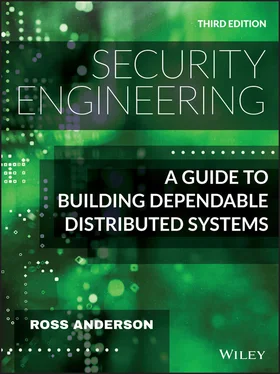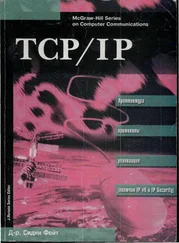An early example was rotor machines , mechanical stream-cipher devices that produce a very long sequence of pseudorandom states 2and combine them with plaintext to get ciphertext. These machines were independently invented by a number of people from the 1920s, many of whom tried to sell them to the banking industry. Banks weren't in general interested, for reasons we'll discuss below, but rotor machines were very widely used by the combatants in World War II to encipher radio traffic, and the efforts made by the Allies to decipher German traffic included the work by Alan Turing and others on Colossus, which helped kickstart the computer industry after the war.
Stream ciphers have been widely used in hardware applications where the number of gates had to be minimised to save power. However, block ciphers are more flexible and are more common in systems being designed now, so let's look at them next.
5.2.3 An early block cipher – Playfair
The Playfair cipher was invented in 1854 by Sir Charles Wheatstone, a telegraph pioneer who also invented the concertina and the Wheatstone bridge. The reason it's not called the Wheatstone cipher is that he demonstrated it to Baron Playfair, a politician; Playfair in turn demonstrated it to Prince Albert and to Viscount Palmerston (later Prime Minister), on a napkin after dinner.
This cipher uses a 5 by 5 grid, in which we place the alphabet, permuted by the key word, and omitting the letter ‘J’ (see Figure 5.6):
| P |
A |
L |
M |
E |
| R |
S |
T |
O |
N |
| B |
C |
D |
F |
G |
| H |
I |
K |
Q |
U |
| V |
W |
X |
Y |
Z |
Figure 5.6 : The Playfair enciphering table
The plaintext is first conditioned by replacing ‘J’ with ‘I’ wherever it occurs, then dividing it into letter pairs, preventing double letters occurring in a pair by separating them with an ‘x’, and finally adding a ‘z’ if necessary to complete the last letter pair. The example Playfair wrote on his napkin was ‘Lord Granville's letter’ which becomes ‘ lo rd gr an vi lx le sl et te rz’.
| Plain |
lo rd gr an vi lx le sl et te rz |
| Cipher |
MT TB BN ES WH TL MP TA LN NL NV |
Figure 5.7 : Example of Playfair enciphering
It is then enciphered two letters at a time using the following rules:
if the two letters are in the same row or column, they are replaced by the succeeding letters. For example, ‘am’ enciphers to ‘LE’;
otherwise the two letters stand at two of the corners of a rectangle in the table, and we replace them with the letters at the other two corners of this rectangle. For example, ‘lo’ enciphers to ‘MT’.
We can now encipher our specimen text as follows:
Variants of this cipher were used by the British army as a field cipher in World War I, and by the Americans and Germans in World War II. It's a substantial improvement on Vigenère as the statistics that an analyst can collect are of digraphs (letter pairs) rather than single letters, so the distribution is much flatter and more ciphertext is needed for an attack.
Again, it's not enough for the output of a block cipher to just look intuitively “random”. Playfair ciphertexts look random; but they have the property that if you change a single letter of a plaintext pair, then often only a single letter of the ciphertext will change. Thus using the key in Figure 5.7, rdenciphers to TBwhile rfenciphers to OBand rgenciphers to NB. One consequence is that given enough ciphertext, or a few probable words, the table (or an equivalent one) can be reconstructed [740]. In fact, the quote at the head of this chapter is a Playfair-encrypted message sent by the future President Jack Kennedy when he was a young lieutenant holed up on a small island with ten other survivors after his motor torpedo boat had been sunk in a collision with a Japanese destroyer. Had the Japanese intercepted it, they might possibly have decrypted it, and history could be different. For a stronger cipher, we will want the effects of small changes in the cipher's input to diffuse completely through its output. Changing one input bit should, on average, cause half of the output bits to change. We'll tighten these ideas up in the next section.
The security of a block cipher can also be greatly improved by choosing a longer block length than two characters. For example, the Data Encryption Standard (DES), which is widely used in payment systems, has a block length of 64 bits and the Advanced Encryption Standard (AES), which has replaced it in most other applications, has a block length of twice this. I discuss the internal details of DES and AES below; for the time being, I'll just remark that we need more than just an adequate block size.
For example, if a bank account number always appears at the same place in a transaction, then it's likely to produce the same ciphertext every time a transaction involving it is encrypted with the same key. This might allow an opponent to cut and paste parts of two different ciphertexts in order to produce a valid but unauthorised transaction. Suppose a crook worked for a bank's phone company, and monitored an enciphered transaction that he knew said “Pay IBM $10,000,000”. He might wire $1,000 to his brother causing the bank computer to insert another transaction saying “Pay John Smith $1,000”, intercept this instruction, and make up a false instruction from the two ciphertexts that decrypted as “Pay John Smith $10,000,000”. So unless the cipher block is as large as the message, the ciphertext will contain more than one block and we'll need some way of binding the blocks together.
The third classical type of cipher is the hash function . This evolved to protect the integrity and authenticity of messages, where we don't want someone to be able to manipulate the ciphertext in such a way as to cause a predictable change in the plaintext.
After the invention of the telegraph in the mid-19th century, banks rapidly became its main users and developed systems for transferring money electronically. What's ‘wired’ is a payment instruction, such as:
‘To Lombard Bank, London. Please pay from our account with you no. 1234567890 the sum of £1000 to John Smith of 456 Chesterton Road, who has an account with HSBC Bank Cambridge no. 301234 4567890123, and notify him that this was for “wedding present from Doreen Smith”. From First Cowboy Bank of Santa Barbara, CA, USA. Charges to be paid by us.’
Since telegraph messages were relayed from one office to another by human operators, it was possible for an operator to manipulate a payment message.
In the nineteenth century, banks, telegraph companies and shipping companies developed code books that could not only protect transactions but also shorten them – which was important given the costs of international telegrams at the time. A code book was essentially a block cipher that mapped words or phrases to fixed-length groups of letters or numbers. So “Please pay from our account with you no.” might become ‘AFVCT’. Sometimes the codes were also enciphered.
The banks realised that neither stream ciphers nor code books protect message authenticity. If, for example, the codeword for ‘1000’ is ‘mauve’ and for ‘1,000,000’ is ‘magenta’, then the crooked telegraph clerk who can compare the coded traffic with known transactions should be able to figure this out and substitute one for the other.
Читать дальше











